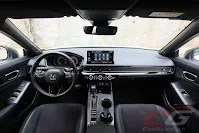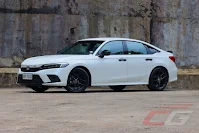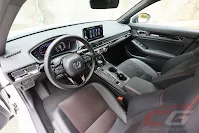The compact car segment is fast shrinking here in the Philippines. What was once considered as the starter family car has now been replaced by genre-bending crossovers, SUVs, and even pick-up trucks. Despite the volume thinning faster than a guy in his forties, not everyone’s giving up on the segment just yet. Case in point is Honda and their all-new Civic RS Turbo.
This isn’t the first time we’ve driven the all-new Civic. You can read our take on the base Civic S Turbo as well as the Civic V Turbo. In those occasions, Honda’s compact sedan did show flashes of brilliance, but was let down by its lack of plush trimmings befitting their respective price tags. It was as if bean counters already had a price point in mind and told product planners to randomly cut out features simply to meet their financial targets with no rhyme or reason. Thankfully, that’s not the case with the Civic RS Turbo. This is, at least in the local sense, befitting to be called the ultimate form of Honda’s eleventh-generation compact sedan.
Starting with the exterior, the Civic RS Turbo dons a sportier garb. Now, compared to past RS executions, the transformation here is more conservative. Aside from the spattering of high-gloss black accents, larger wheels, exposed dual tail pipes, and rear wing, it’s close visually to the Civic V Turbo. Honda has resisted the temptation to add fake vents and ducting this time around, and for that, adheres closely with this generation Civic’s more grown-up character.
Of note: I’ve never found the Civic’s sportscar-like 134-mm ground clearance to be an issue, but judging by the way other motoring journos treated this Platinum White Pearl unit, it’s not exactly Manila proof either. The trailing edges of the front bumper (both sides) and even the side skirts are battle scared from whatever parking ramp or speed hump they had to tackle.
What I found to be the bigger issue is the Civic RS Turbo’s comically large turning radius. Honda’s official figures read 5.7 meters which, at first, seems like a typo because it’s equal to the Mitsubishi Montero Sport and Nissan Terra’s figure (and just 100 mm shy of Fortuner and mu-X), but it’s a fact that smacks you right in your face as you negotiate your first U-Turn slot or execute your first parallel parking maneuver. There’s a street slang for this and it’s called tiis-ganda.
The Civic RS Turbo’s lack of low-speed maneuverability aside, it stays close to the overall driving experience delivered by the other Civic variants. The road manners are class-leading thanks to its quick, precise steering feel and a chassis that balances grip and comfort. Whether you’re negotiating Manila’s snarling traffic, traversing billiard smooth expressways, or tackling curvy mountain passes, it’s stable and predictable. However, for all its mechanical accuracy and finesse, it isn’t evocative. It doesn’t offer a high level of driver involvement. Instead, it feels like a cold, sharp surgeon’s tool.
Sharing the same engine with the rest of the Civic line-up, the Civic RS Turbo has a slight weight disadvantage over the rest of the line-up (23 kilograms up from the Civic V Turbo and 33 kilograms up from the Civic S Turbo), but from the driver’s seat, it doesn’t feel all that different. Honda concentrated on reducing the turbo lag and improve mid-range punch with this turbocharged engine, and it’s worked. The engine never feels stressed, and it always feels like it’s got power in reserve. It won’t shove or dig you into your seat, but it has power and torque whenever you need or demand it. The added weight also hasn’t added sort of fuel efficiency penalty. At 8.92 km/L (average speed 17 km/h), it’s pretty much the same as the other variants.
The biggest differentiator of the Civic RS Turbo is the availability of a third driving mode. Aside from Econ and Normal, it adds Sport too. Accessing it requires toggling through a switch near the gear lever, and for the most part, it’s noticeable. Not only does it change the behavior of the engine, but it also re-maps the gearbox and the throttle pedal’s sensitivity as well. Previously, the CVT gearbox was the Civic’s weakest link in terms of driving experience, but thanks to the added mode and some other tweaks, it’s been improved here. Oddly enough, switching over to Sport seems to disengage the built-in shift logic (or at least, I couldn’t get it simulate gear shifting); instead, it keeps the engine singing in its peak power and torque range. The drone-y note is the tradeoff for a much punchier feel. At least there are paddle shifters for those who want to keep a level of driver control or want to minimize the in-cabin drone.
Inside, it’s very clear that Honda’s poured all their resources in making the Civic RS Turbo feel more upscale and premium compared to the non-RS trims. The plastics are actually different here with more soft-padded surfaces. The thick-rimmed three-spoke wheel is covered in leather, while the seats are finished in a nice combination of leather and suede. The execution, too, is tastefully modern with the dash-width air vents and authentic metal finish.
It scores high in terms of ergonomics too. The low seating position makes you feel like you’re sitting in a bathtub, but once you adjust for that, visibility is more or less superb thanks to the thin A-pillar and re-positioned side mirrors. The tall rear parcel shelf partially obscures the backend, so thankfully, a rear-view camera, but no sensors, is standard. The rest of the controls is positioned exactly where you expect them to be. With a full digital instrumentation, Honda’s opted to put two scroll wheels here instead of one. The left controls the left side of the screen (reserved for the infotainment), while the right one controls the right side (Honda SENSING, trip computer, navigation). Drivers can even toggle between two types of gauges—a round and a bar-type.
At the center is a 9-inch touchscreen (two inches bigger than the one fitted in the non-RS variants). It’s a clear upgrade from Honda’s previous infotainment efforts because it’s snappier and dotted with sharp graphics. The screen itself is also coated to better resist fingerprints and reflections, but thankfully there’s a row of physical buttons, including a traditional volume knob. Ditto the climate control functions which are large, easy-to-decipher knobs.
Exclusive to the Civic RS Turbo is wireless Apple CarPlay. Together with standard wireless device charging, it should, at least on paper, make for one seamless smartphone integration experience. Sadly, ditching the wires results in a laggy, buggy experience. It randomly hangs or disconnects with a paired mobile phone. Plus, because the wireless charging tray barely accommodates a “normal-sized” iPhone such as an iPhone 8, owners of larger iPhones mean they’re out of luck keep their phone secured. In my opinion, stick with the corded CarPlay and turn off the wireless charging mat for the best smartphone experience.
Space-wise, the Civic RS Turbo is huge. It genuinely encroaches into the executive sedan (D-segment) category, especially when it comes to shoulder and legroom. The rear headroom though has been compromised somewhat, as is the available trunk space. Not only is it smaller than the previous-generation Civic, but the addition of the shelf-mounted subwoofer for the Bose sound system also shaved some liters off (495 liters versus 497 liters).
Like the rest of the Civic family, Honda’s prioritized safety here as part of their zero fatalities goal. With that, Honda SENSING is standard. Bundling all the driver tech not only reduces the occurrences of a crash, but it also adds a layer of convenience during long drives (lane centering and all-speed adaptive cruise control being the most helpful). Moreover, it helps you save on your car’s insurance as well. It’s also well-suited to the local road conditions since it didn’t produce a single false warning after a week’s worth of driving. If I had my way though, I would have swapped the Lane Watch system for proper blind spot indicators. Not only is the camera low-res, but it overrides anything displayed on the infotainment system the moment you switch on the right turn signal. For those who’re reliant on Waze or Google Maps to negotiate through an unfamiliar place, this can pose a problem. And sure, the camera can be defeated using a button on the left stalk, but that pretty much defeats the purpose of having Lane Watch, right?
As the compact car segment has become increasingly niche, players in this segment had to adopt. From being the every man’s car, today, cars such as the Civic RS Turbo are meant to serve a more discerning market. Priced at P 1.690 million, they’re lumped together with other, more seemingly practical choices. That said, buyers who go for today’s compact cars tend to go for something more sophisticated. More so, they’re willing to pay more to get the features and the driving experience they want. Coming from the Civic V Turbo’s solid mechanical foundations, refined cabin, and grown-up aesthetics, the Civic RS Turbo add the proper sprinkling of tech and luxury amenities. Despite its minor flaws, ultimately it satisfies this new breed of customer who’re zeroing in on one of the best, if not the best compact sedan experience out there.
|
2022 Honda Civic RS Turbo |
|
| Ownership | 2022 Honda Civic RS Turbo Honda SENSING |
| Year Introduced | 2022 |
| Vehicle Classification | Compact Car |
| Warranty | 3 years / 100,000 kilometers |
| The Basics | |
| Body Type | 4-door sedan |
| Seating | 5 |
| Engine / Drive | F/F |
| Under the Hood | |
| Displacement (liters) | 1.5 |
| Aspiration | Turbocharged |
| Fuel Delivery | EFI |
| Layout / # of Cylinders | I4 |
| BHP @ rpm | 178 @ 6,000 |
| Nm @ rpm | 240 @ 1,700-4,500 |
| Fuel / Min. Octane | Gasoline / 91~ |
| Transmission | CVT |
| Cruise Control | Yes, Adaptive |
| Fuel Economy @ Ave. Speed | 8.92 km/L @ 17 km/h |
| Dimensions and Weights | |
| Length (mm) | 4,678 |
| Width (mm) | 1,802 |
| Height (mm) | 1,415 |
| Wheelbase (mm) | 2,735 |
| Curb Weight (kg) | 1,337 |
| Suspension and Tires | |
| Front Suspension | Independent, MacPherson Strut |
| Rear Suspension | Independent, Multi-link |
| Front Brakes | Vented Disc |
| Rear Brakes | Disc |
| Parking Brake | Electric, w/ Auto Hold |
| Tires | Michelin Pilot Sport 4 235/40 R 18 Y (f & r) |
| Wheels | Alloy |
| Safety Features | |
| Airbags | 6 |
| Anti-Lock Brakes (ABS) | Yes, with EBD |
| Traction / Stability Control | Yes |
| Parking Sensors | No |
| Parking Camera | Yes, Rear |
| Front Seatbelts | 3-pt ELR w/ pre-tensioners x 2 |
| Rear Seatbelts | 3-pt ELR x 3 |
| ISOFIX Child Seat Anchor | Yes |
| Other Safety Features |
Collision Mitigation Braking Lane Keep Assist Lane Departure Warning Road Departure Warning Lead Car Departure Notification Lane Watch Blind Spot Camera |
| Exterior Features | |
| Headlights | LED |
| Fog Lamps | Yes, Front (LED) |
| Auto Lights | Yes |
| Rain-sensing Wipers | Yes |
| Tailgate | Manual |
| Interior Features | |
| Steering Wheel Adjust | Tilt/Telescopic |
| Steering Wheel Material | Leather |
| Seating Adjustment (driver) | 8-way, Power |
| Seating Adjustment (front passenger) | 4-way, Manual |
| Seating Surface | Leather/Suede |
| Folding Rear Seat | Yes, 60/40 |
| Sunroof | No |
| Trip Computer | Yes |
| Convenience Features | |
| Power Steering | Yes |
| Power Door Locks | Yes |
| Power Windows | Yes |
| Power Mirrors | Yes, w/ Fold |
| Rear View Mirror | Auto-dimming |
| Proximity Key | Yes |
| Climate Control | Yes, Dual Zone w/ Rear Vents |
| Audio System |
Stereo USB Bluetooth GPS |
| Smartphone Connectivity |
Apple CarPlay Android Auto |
| # of Speakers | 12, Bose |
| Steering Controls | Yes |


























Why did Honda Thailand axe this variant in favor of a hybrid version? Will our market follow suit?
ReplyDeleteThailand already has favorable laws on electrified vehicles so it made sense for Honda to start shifting their vehicles to the e:HEV technology. Eventually, we'll make that shift as well, but perhaps not right now. At best, the e:HEV will co-exist with the current turbo engine. My bet is that they'll introduce e:HEV with the HR-V which has yet to see a RS variant.
DeleteBetter than the Mazda3?
ReplyDeleteFor driver involvement and feel? No. As an overall package? Yes.
Deletebetter as an overall package even considering that the hatchback mazda is more versatile than the civic's sedan form?
DeleteHatch size is one thing...the Mazda3 hatchback has about 569 liters of trunk space to the Civic's 495, but I'd counter that with the Civic's larger interior space.
DeleteSince compact cars has become niche, mainstream brands should offer a coupe version as TOTL ala Kia Forte Koup of yesteryears. Id buy a coup version of the Mazda 3 (I imagine it will resemble like the Vision Coupe concept albeit smaller). Feeling pogi ka on your daily commute at a (relative) bargain 😎
ReplyDeleteKaya nga "feeling" eh haha. Life is fair naman. May pambawi sa ibang bagay haha
DeleteAno kaya pambawi sa buhay... Definitely not intellect. Baka malaki namana?
DeleteNo intellect, no wealth, no beauty, no charm/personality. I am from the machine world programmed to spread the message how chappy Ford is 🤖
DeleteMay "anger management problem" ata ang fan ni rg lol. Anyway h a freedom of speech, sir uly wla na ata naga comments since u required sign in, maybe we shall let them say wat they want to say, mas masaya kc yon ha ha. Mabe u can juz delet toxic coments
DeleteHave you noticed that RG also mysteriously disappeared as well?
DeleteRG disappeared ngayon ko lang napansin, also his fans disappeared as well ahahaha
DeleteThis thing still doesn't look like it's worth 1.7M PhP. Get the base variant and you have 400K for upgrades at any time.
ReplyDeleteUly, the S & V variants have an S mode on the shifter itself, what's the difference between that & the Sports mode toggle on the RS? Shouldn't those be the same thing?
ReplyDeleteThe S mode in the S & V grades just makes the CVT ratio more aggressive--it keeps the revs higher. The Sport mode on the RS does that but also changes the accelerator pedal response as well as engine mapping. Think of the S as overdrive off in the traditional PRND4321 layout.
DeleteI hope Honda Ph will bring in the hatchback variant too to compete with the Mazda 3.
ReplyDeleteI don't think the Civic hatchback will come. Honda stopped the production of that variant in Thailand.
DeleteCivic Hatchback ain't gonna be produced in Thailand due to very low demand for it..Not worth it
ReplyDeleteHi Uly, are there any upgrades underneath the Civic RS (similar to the HR-V RS) compared to the S and V variants?
ReplyDeleteThe Civic RS Turbo does have different tracks compared to the S and V...but that's down to being able to fit the wider 18-inch wheels. They didn't say anything else though so I presume it's the same underneath.
Delete